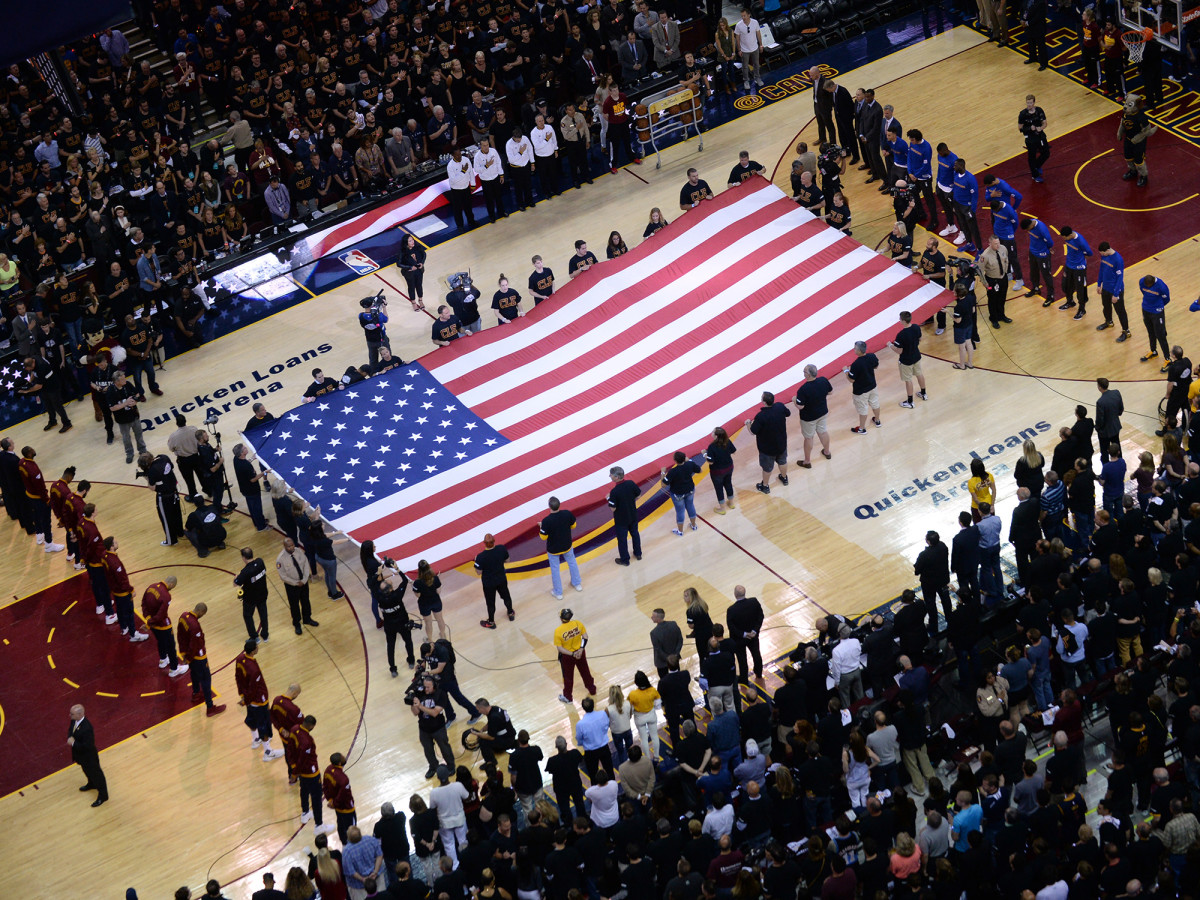How should the NBA handle national anthem protests?

San Francisco 49ers quarterback Colin Kaepernick’s decision to kneel during the national anthem has been a dominant news story for a month straight—and the protests are expected to continue into the foreseeable future.
The practice has spread across the NFL, forcing the players’ decision to sit—and their reasons for doing so—to become a topic that’s being discussed every Sunday. The protests have led to both donations to aid communities in need as well as meetings between football players and police chiefs.
With anthem protests proving to be an impactful way to stir engagement on issues of racial inequality and police brutality, NBA players like Thunder guard Victor Oladipo believe the approach will carry over to the NBA season. Cavaliers guard Iman Shumpert has already indicated he will be kneeling for the anthem, and with training camps starting up soon, we’ll undoubtedly hear more players address the issue.
Beyond racism? A look at Newton's changing stance on race as Kaepernick heads to town
In the event that NBA players do start some form of protest before games this season, how should commissioner Adam Silver handle it?
An anthem protest in this socially conscious time for the NBA would close a circle of sorts. In 1996, then-Nuggets guard Mahmoud Abdul-Rauf refused to stand for the anthem, saying the song conflicted with his Muslim beliefs. The NBA actually suspended Abdul-Rauf for a game because of his protest, and eventually convinced him to stand. Abdul-Rauf was out of the league a couple years after his protest, with his career being cut short sooner than it probably should have been.
Under Silver’s tenure, the NBA has shown a much greater social awareness, which is somewhat refreshing for a sports league or major corporation. Silver properly handled both the Donald Sterling and North Carolina HB2 situations, while the league’s players have spoken out more than ever before, whether it was rebuking Sterling, wearing hoodies for Trayvon Martin or sporting “I Can’t Breathe” shirts during warmups. (Contrast those happenings with the previous NBA regime, during which David Stern started a dress code and policed what players could wear to games.)
Though the league has come a long way socially, no NBA player has had a message as pinpointed as Kaepernick’s.

While LeBron James, Carmelo Anthony, Chris Paul and Dwyane Wade showed a level of courage in their national address to end violence at the ESPYs, they also didn’t reach as far out as Kaepernick, who took a definitive stance against police violence, and has explained clearly and concisely how he hopes to begin a conversation about oppression.
What remains to be seen is how the NBA would deal with its players if they began to specifically call out the police or other institutions with a visible protest. The “I Can’t Breathe” shirts were the closest NBA players came to a protest on Kaepernick’s level, but wearing different shirts in warmups is far less disruptive than sitting during the anthem, which to many—as Kaepernick has proven—has been conflated with what it means to be a patriot.
How should the NBA handle a potential anthem protest? They should let the players do whatever they want, and if the NBA truly fashions itself as the progressive sports league, the Association should go beyond tacit support, it should actively work to help bring resolutions to the issues players could raise.
By the time the season starts, the NBA will have had months to decide how it wants to react to anthem protests. With 82 games on the schedule as opposed to 16 in the NFL, the NBA actually has a chance to normalize these protests, to show that it’s okay to use every single game as a platform for peaceful demonstration.
A history of athletes protesting the national anthem
A blanket statement reinforcing the players’ rights and supporting the military is not enough, especially since Silver has been a commissioner known for taking action. In a league that’s nearly three-quarters black, Silver should follow the lead of his players, who are far more affected by the issues they bring to light than Silver could ever know.
Ultimately, both the NBA front office and its players could be tested in a way once the season starts. Will the league’s star players be willing to go out on the same branch as Kaepernick? And will Silver handle the situation in a way that satisfies the protesters?
The fact that those questions can even be asked—20 years after Abdul-Rauf was suspended for sitting for the anthem—at least suggests (and creates hope for more) progress.
